Welcoming a dog into your home is one of the most fulfilling and unforgettable moments you can have. Dogs, after all, are some of the best companions with their unconditional love, unwavering loyalty, and constant affection.
So, yeah, it is an exciting venture, but it's one with many challenges, particularly in the form of energetic fluffballs who may munch on everything they come across. It may be easy to scold a dog who's exploring a new environment, but it's easier to prep your home.
Today, let's walk through your house and discuss how you can dog-proof rooms to avoid mishaps, broken wires, and nibbled shoes in the near future.
The Living Room
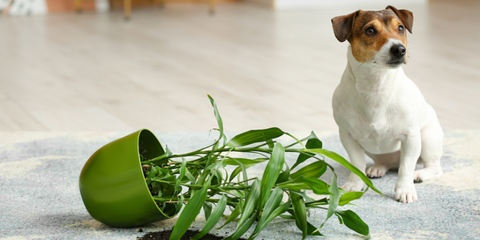
The living room is one of the most frequented spaces in your home. It's where your household comes together to spend time, watching television and enjoying everyone's company.
It'd be a shame to keep your precious pup out of this room just because they're a bit naughty. Here are some ways you can dog-proof your living room.
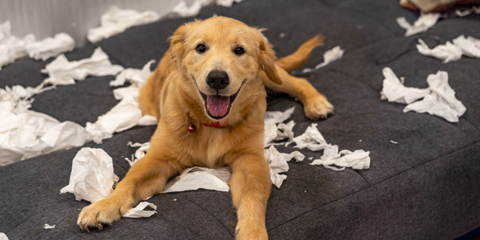
- Cord Management: Cord concealers and organisers are some of the best tools to use as a fur parent. These items keep electrical cords out of sight and away from sharp doggy teeth.
- Pet-Friendly Houseplants: Plants help brighten rooms and improve air quality. However, some houseplants, like aloe, are toxic to dogs, so check if your chosen plants are safe before decorating the room.
- Anti-Slip Rugs: If you have hardwood floors or tiles, consider using anti-slip rugs in common areas to prevent them from sliding around. Regular rugs may be a safety hazard for you and energetic pups.
- Furniture Protectors: Dogs can be as destructive as they are cute, especially in their younger years. If possible, install slipcovers and furniture protectors to shield your furniture from scratches and pet hair. They help prevent permanent damage and are easy to clean.
- Supervision Tools: As much as you want to, you can't always be with your pet. If you're worried about leaving them alone, consider using baby monitors or pet cameras to watch your dog when you're not in the room.
The Kitchen

Have you ever woken up to the smell of bacon and eggs in the morning? If you tend to gravitate towards the kitchen because of the scent of food, your dog will likely do the same. After all, they enjoy a yummy snack as much as you do.
Try these dog-proofing tips for your kitchen to avoid mishaps and missing foods.

- Trash Cans: Dogs are curious by nature, and they're also notorious for rummaging through trash. If you don't want your pup to get into food waste, invest in a trash can with a secure lid or a heavy container that can't tip over.
- Pet-Proof Pantry: Food storage can be tricky, but the rule of thumb is to secure items in containers that dogs can't chew through. If you have a pantry, keep it closed and locked, with food and other kitchen objects safe on high shelves.
- Stove and Oven Safety: Use knob covers or guards on your stove and oven to prevent your dog from accidentally turning them on. Keep pot handles turned inward so they can't be knocked over.
- Clear Countertops: Avoid leaving food or enticing items on the kitchen countertops. Your dog might be tempted to jump up and help themselves. Use a designated space or storage for food items.
- Cleaning Supplies: Store cleaning supplies in locked or high cabinets to prevent accidental ingestion. Be mindful of leaving cleaning residue on surfaces, as your dog may lick or chew on these areas.
The Bedroom
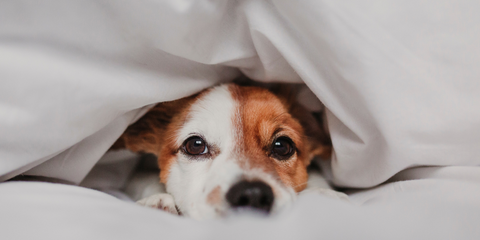
Ah, the bedroom -- your haven from the outside world. This is where you can fully unwind and shrug off the stress of your everyday life. It can also be a shared space with your pup.
Let's see how you can improve your bedroom and make it dog-proof.
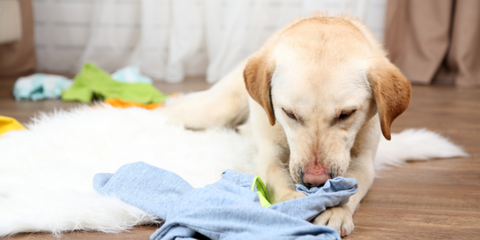
- Electrical Cords: Chargers and cables are fun to play with and chew through for doggies, especially pups. If you can't hide them, utilise cable hooks and tapes to attach them to walls, avoiding electrical hazards or device damage.
- Pet-Friendly Bedding: Consider using easy-to-clean or pet-hair-resistant beddings in your bedroom. An alternative is to use bed covers to go on top of your pillows and blankets when you aren't in bed.
- Shoes and Footwear: Dogs may be tempted to chew on shoes or slippers left on the floor. Store your footwear in a closet or a shoe rack to prevent unwanted chewing.
- Wardrobe Doors: Make sure wardrobe or closet doors are secure, especially if they contain shoes, clothes, or items your dog might find appealing.
- Regular Cleaning: Vacuum and clean your bedroom regularly to control pet hair and allergens. Doing so is especially important if your dog has access to the bedroom.
The Bathroom
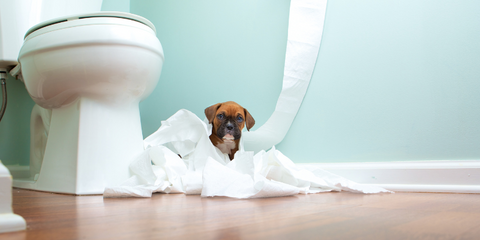
The bathroom poses its own set of challenges when it comes to dog-proofing. Here are some tips to ensure a safe and pet-friendly bathroom environment:

- Toilet Lid: Keep the toilet lid closed to prevent your dog from drinking or playing in the toilet water. Cleaning products are also harmful if ingested by curious pups.
- Loose Towels and Linens: Dogs might see hanging towels or bathrobes as toys. Keep them out of reach to prevent your dog from pulling them down or chewing on them.
- Childproof Cabinet Locks: Install childproof locks on bathroom cabinets that contain cleaning supplies, medications, or other potentially hazardous items.
- The Hamper: If you have a laundry hamper in the bathroom, keep it closed or in a closet. Dogs may be drawn to dirty laundry, which can pose a choking hazard.
- Bath Products: If you use bath products like bath salts or essential oils, store them securely. Some substances can be toxic to dogs if ingested or absorbed through the skin.
Bonus Tips
- Baby Gates: If you're worried about your dog going into rooms they shouldn't enter, consider installing baby gates in various parts of your home. Smaller breeds are easily stopped by these gates, and bigger dogs will have difficulty crossing them.
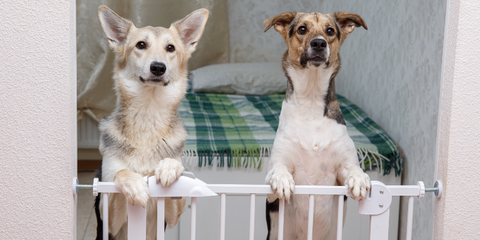
- Carpets and Rugs: Make sure carpets and rugs in the hallway are securely fastened to prevent tripping hazards. Dogs can sometimes get tangled in loose carpets.
- Rest Space: Dogs are excellent at associating specific areas and items to key activities in their routine. If you don't mind them sleeping in your bedroom, ensure that they don't eat or play in this space to make it easy for them to rest.
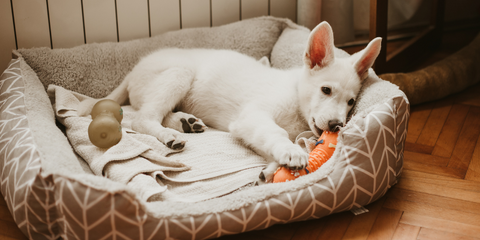
- Clean Floors: As much as possible, you should keep your floors clear of debris and small items. Dogs are naturally curious and are not afraid to eat things to sate their curiosity.
- Pet-Friendly Artwork: If you have artwork on the hallway walls, make sure it's securely mounted and not at your dog's eye level. This prevents accidental collisions.
Bonus Tips
Congrats! You now know several handy tips that can help you dog-proof your home. Remember, dog-proofing isn't just about saving your space from disaster, you also do it to ensure your canine companion has a safe space to live in.
Happy dog-proofing!

